Přehled aktuálních odborných článků na kterých se podíleli členové a studenti Katedry fyzické geografie a geoekologie PřF UK.
Langhammer, J., Lendzioch, T., Vlček, L. (2024). Montane peatland response to drought: Evidence from multispectral and thermal UAS monitoring, Ecological Indicators 167, 112587. https://doi.org/10.1016/j.ecolind.2024.112587.
 Studie se zabývá reakcí horských rašelinišť ve středních zeměpisných šířkách na oteplování klimatu a zaměřuje se na změny, ke kterým došlo v horském rašeliništi během období sucha. Pro snímkování s vysokým rozlišením a přístrojové monitorování byly použity bezpilotní letecké systémy (UAS, drony) vybavené multispektrálními a termálními senzory. Tato studie poprvé přesně zdokumentovala rozsah a intenzitu strukturálních změn a tepelnou odezvu horských rašelinišť na intenzivní sucho. Výsledky zdůraznily účinnost monitorování pomocí UAS při pochopení horských rašelinišť jako křehkého prostředí vystaveného účinkům klimatických změn.
Studie se zabývá reakcí horských rašelinišť ve středních zeměpisných šířkách na oteplování klimatu a zaměřuje se na změny, ke kterým došlo v horském rašeliništi během období sucha. Pro snímkování s vysokým rozlišením a přístrojové monitorování byly použity bezpilotní letecké systémy (UAS, drony) vybavené multispektrálními a termálními senzory. Tato studie poprvé přesně zdokumentovala rozsah a intenzitu strukturálních změn a tepelnou odezvu horských rašelinišť na intenzivní sucho. Výsledky zdůraznily účinnost monitorování pomocí UAS při pochopení horských rašelinišť jako křehkého prostředí vystaveného účinkům klimatických změn.
Vargas Godoy, M. R., Markonis, Y., Rakovec, O., Jenicek, M., Dutta, R., Pradhan, R. K., Bešťáková, Z., Kyselý, J., Juras, R., Papalexiou, S. M., and Hanel, M. (2024). Water cycle changes in Czechia: a multi-source water budget perspective, Hydrol. Earth Syst. Sci., 28, 1–19. https://doi.org/10.5194/hess-28-1-2024.
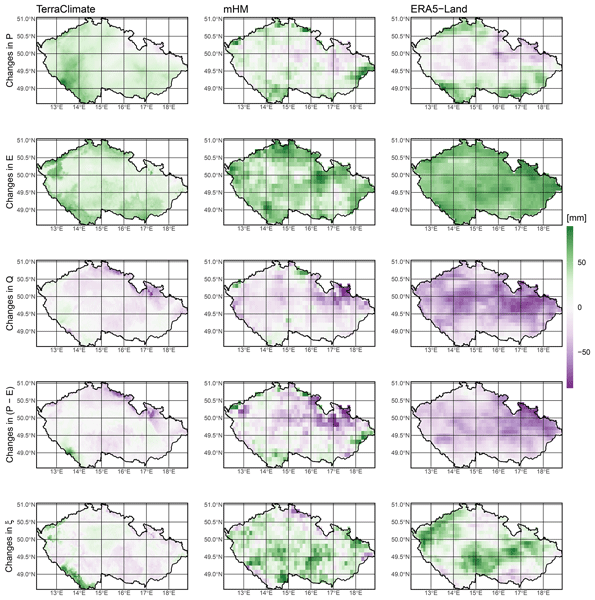 The study introduces a novel benchmarking method based on the water cycle budget for hydroclimate data fusion. Using this method and multiple state-of-the-art datasets to assess the spatiotemporal patterns of water cycle changes in Czechia, we found that differences in water availability distribution are dominated by evapotranspiration. Furthermore, while the most significant temporal changes in Czechia occur during spring, the median spatial patterns stem from summer changes in the water cycle.
The study introduces a novel benchmarking method based on the water cycle budget for hydroclimate data fusion. Using this method and multiple state-of-the-art datasets to assess the spatiotemporal patterns of water cycle changes in Czechia, we found that differences in water availability distribution are dominated by evapotranspiration. Furthermore, while the most significant temporal changes in Czechia occur during spring, the median spatial patterns stem from summer changes in the water cycle.
Garba, R., Usyk, V., Ylä-Mella, L. et al. East-to-west human dispersal into Europe 1.4 million years ago. Nature (2024). https://doi.org/10.1038/s41586-024-07151-3
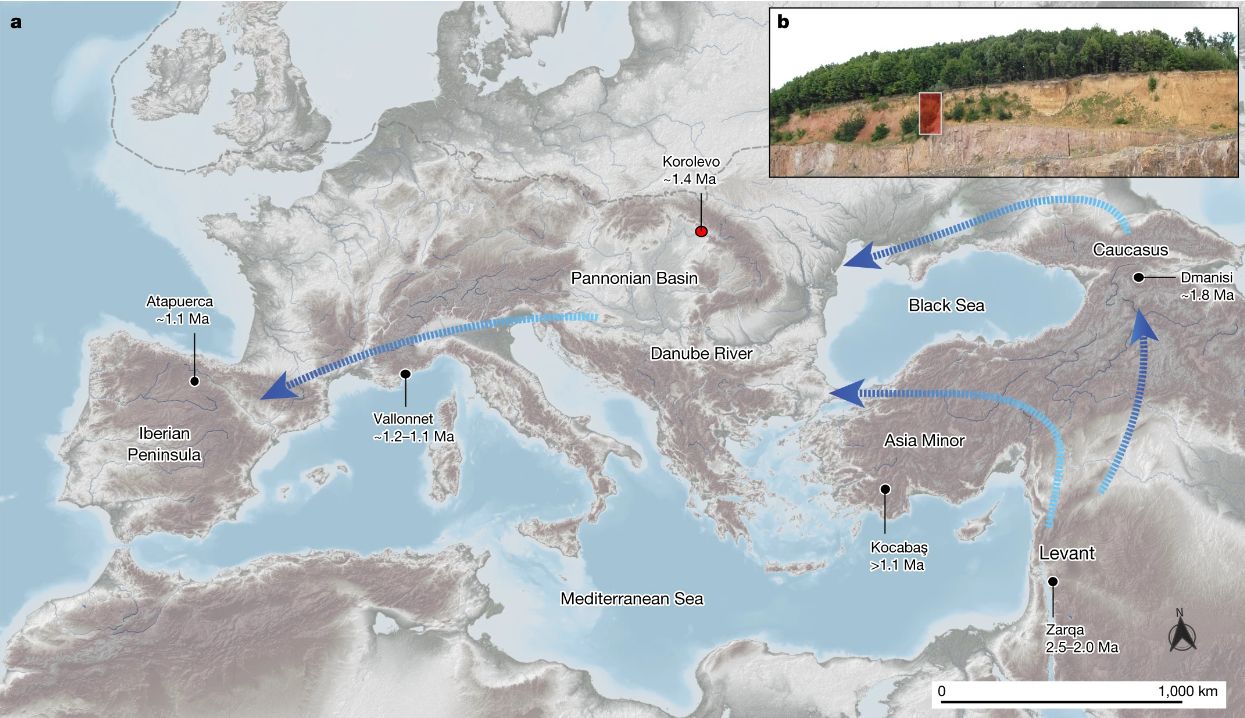 Stone tools stratified in alluvium and loess at Korolevo, western Ukraine, have been studied by several research groups since the discovery of the site in the 1970s. Although Korolevo’s importance to the European Palaeolithic is widely acknowledged, age constraints on the lowermost lithic artefacts have yet to be determined conclusively. Here, using two methods of burial dating with cosmogenic nuclides, we report ages of 1.42 ± 0.10 million years and 1.42 ± 0.28 million years for the sedimentary unit that contains Mode-1-type lithic artefacts. Korolevo represents, to our knowledge, the earliest securely dated hominin presence in Europe, and bridges the spatial and temporal gap between the Caucasus (around 1.85–1.78 million years ago) and southwestern Europe (around 1.2–1.1 million years ago). Our findings advance the hypothesis that Europe was colonized from the east, and our analysis of habitat suitability9 suggests that early hominins exploited warm interglacial periods to disperse into higher latitudes and relatively continental sites—such as Korolevo—well before the Middle Pleistocene Transition.
Stone tools stratified in alluvium and loess at Korolevo, western Ukraine, have been studied by several research groups since the discovery of the site in the 1970s. Although Korolevo’s importance to the European Palaeolithic is widely acknowledged, age constraints on the lowermost lithic artefacts have yet to be determined conclusively. Here, using two methods of burial dating with cosmogenic nuclides, we report ages of 1.42 ± 0.10 million years and 1.42 ± 0.28 million years for the sedimentary unit that contains Mode-1-type lithic artefacts. Korolevo represents, to our knowledge, the earliest securely dated hominin presence in Europe, and bridges the spatial and temporal gap between the Caucasus (around 1.85–1.78 million years ago) and southwestern Europe (around 1.2–1.1 million years ago). Our findings advance the hypothesis that Europe was colonized from the east, and our analysis of habitat suitability9 suggests that early hominins exploited warm interglacial periods to disperse into higher latitudes and relatively continental sites—such as Korolevo—well before the Middle Pleistocene Transition.
Nørgaard, J., Margold, M., Jansen, J. D., Kurbanov, R., Szuman, I., Andersen, J. L., et al. (2023). Absence of large-scale ice masses in central Northeast Siberia during the Late Pleistocene. Geophysical Research Letters, 50, e2023GL103594.
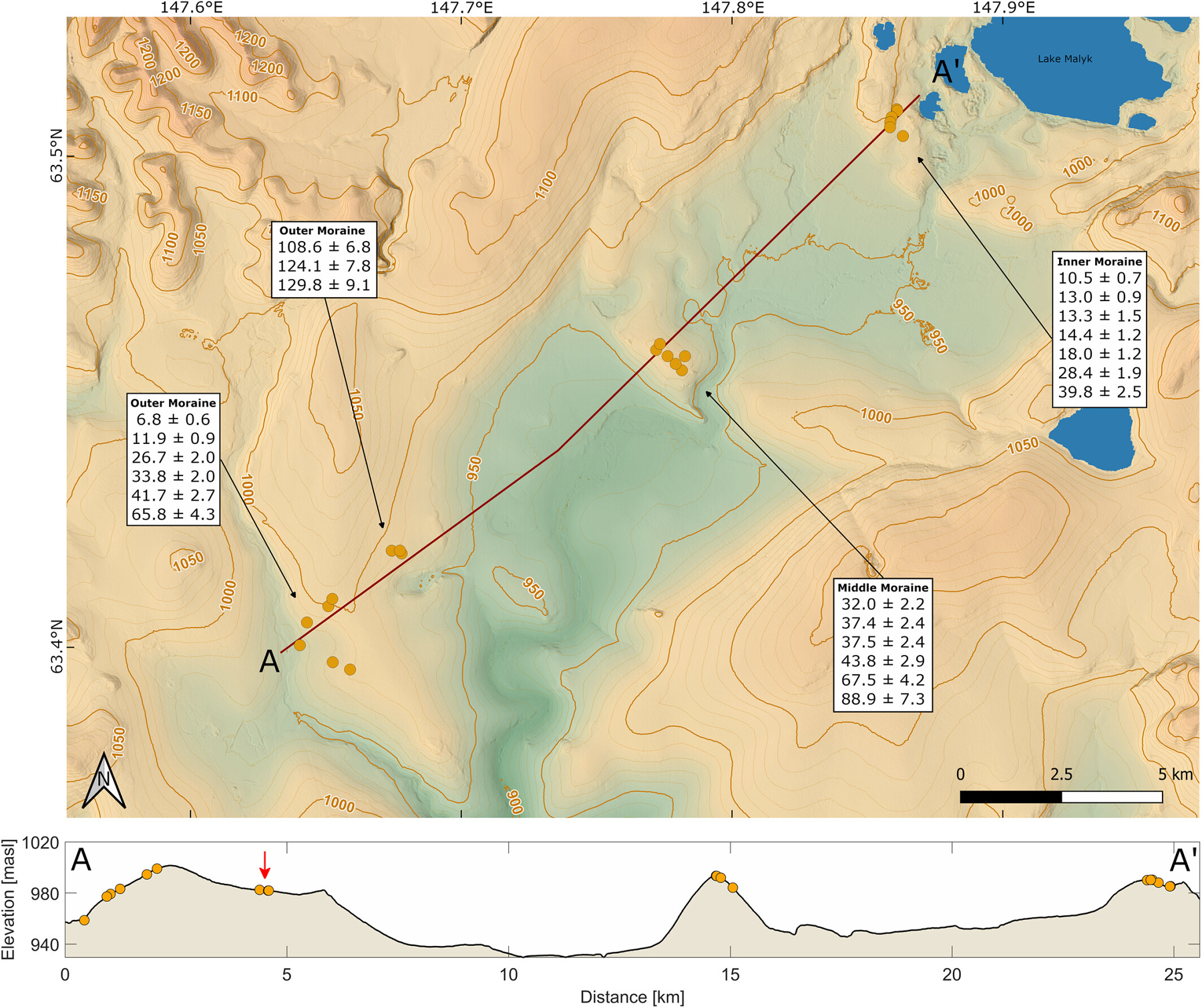 Ongoing speculation regarding the existence of large Late Pleistocene ice masses in Northeast Eurasia reflects the dearth of age constraints on glaciations across this vast region. Here, we report the first dates from the central part of Northeast Siberia, consisting of 22 cosmogenic 10Be exposure ages from boulders deriving from a sequence of three moraines in the Chersky Range. The dated moraine sequence indicates progressive contraction of maximum glacier extent from Marine Isotope Stage 6 to the Last Glacial Maximum, while the remotely-sensed mapping indicates an older, more expansive glaciation in the region yet undated. Our results show that Late Pleistocene glaciations were limited to the highlands, and Northeast Siberia did not host a large, coalescent ice sheet during the Last Glacial Maximum or Marine Isotope Stage 6.
Ongoing speculation regarding the existence of large Late Pleistocene ice masses in Northeast Eurasia reflects the dearth of age constraints on glaciations across this vast region. Here, we report the first dates from the central part of Northeast Siberia, consisting of 22 cosmogenic 10Be exposure ages from boulders deriving from a sequence of three moraines in the Chersky Range. The dated moraine sequence indicates progressive contraction of maximum glacier extent from Marine Isotope Stage 6 to the Last Glacial Maximum, while the remotely-sensed mapping indicates an older, more expansive glaciation in the region yet undated. Our results show that Late Pleistocene glaciations were limited to the highlands, and Northeast Siberia did not host a large, coalescent ice sheet during the Last Glacial Maximum or Marine Isotope Stage 6.
Hotovy, O., Nedelcev, O., Jenicek, M. (2023). Changes in rain-on-snow events in mountain catchments in the rain-snow transition zone. Hydrological Sciences Journal, 68(4), 572-584.
 A shift from snowfall to rain affecting snow storage is expected in future. Consequently, changes in rain-on-snow (ROS) events may occur. We evaluated the frequency and trends in ROS events and their runoff responses at different elevations related to changes in climate variables. We selected 40 central European mountain catchments located in the rain–snow transition zone, and used a conceptual catchment model to simulate runoff components for the period 1965–2019. The results showed large temporal and spatial differences in ROS events and their respective runoff responses across individual study catchments and elevations, with primarily an ROS increase at highest elevations and a decrease at lower elevations during spring. ROS events contributed 3–32% to the total seasonal direct runoff. The detected trends reflect changes in climate and snow variables, with an increase in air temperature resulting in the decrease in snowfall fraction and shorter snow cover period.
A shift from snowfall to rain affecting snow storage is expected in future. Consequently, changes in rain-on-snow (ROS) events may occur. We evaluated the frequency and trends in ROS events and their runoff responses at different elevations related to changes in climate variables. We selected 40 central European mountain catchments located in the rain–snow transition zone, and used a conceptual catchment model to simulate runoff components for the period 1965–2019. The results showed large temporal and spatial differences in ROS events and their respective runoff responses across individual study catchments and elevations, with primarily an ROS increase at highest elevations and a decrease at lower elevations during spring. ROS events contributed 3–32% to the total seasonal direct runoff. The detected trends reflect changes in climate and snow variables, with an increase in air temperature resulting in the decrease in snowfall fraction and shorter snow cover period.
Helen E. Dulfer, Benjamin J. Stoker, Martin Margold & Chris R. Stokes (2023). Glacial geomorphology of the northwest Laurentide Ice Sheet on the northern Interior Plains and western Canadian Shield, Canada, Journal of Maps, DOI: 10.1080/17445647.2023.2181714
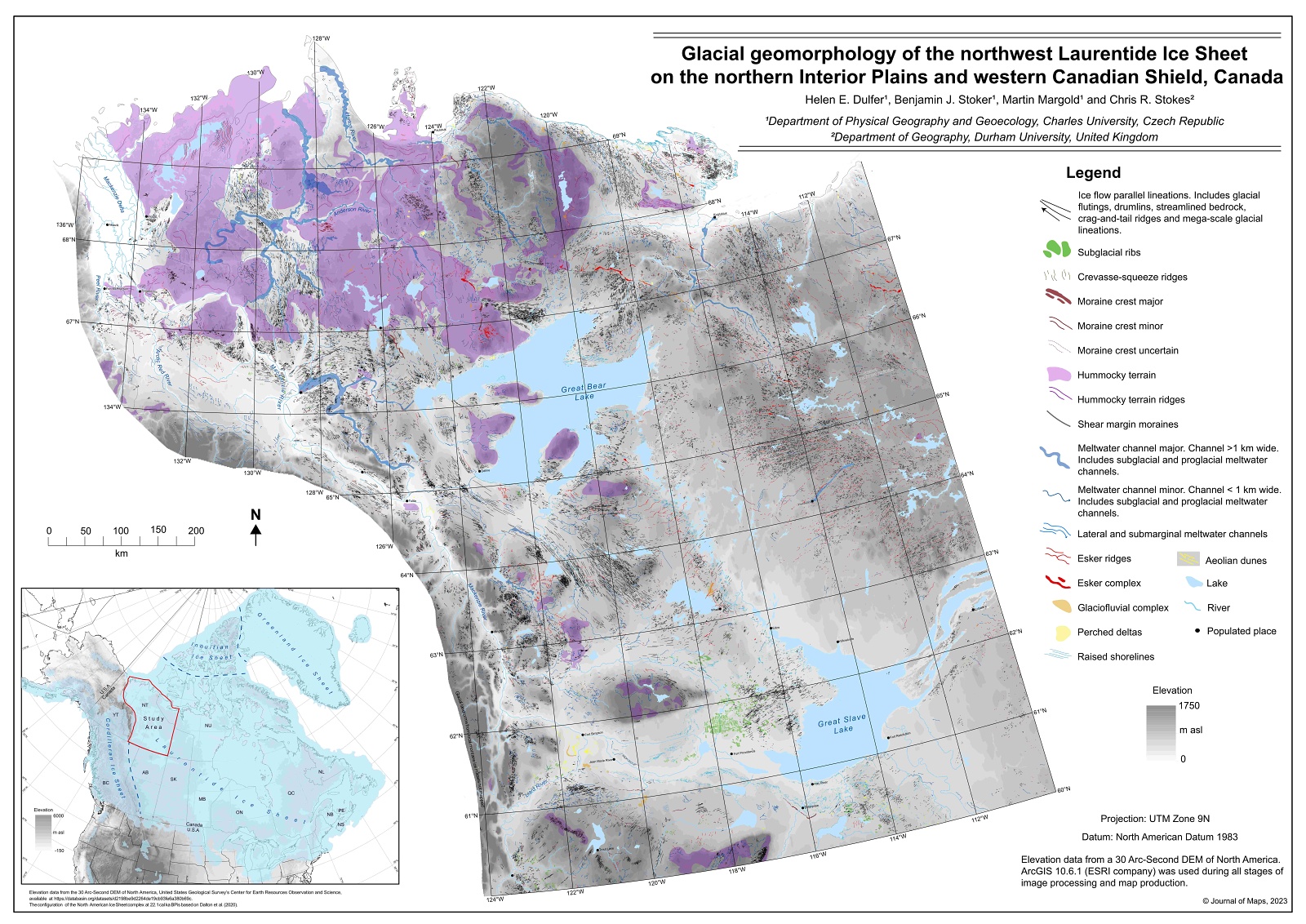 The majority of the Northwest Territories of mainland Canada was covered by the Laurentide Ice Sheet during the Last Glacial Maximum. The increasing coverage of high-resolution remotely sensed data provides new opportunities to map the glacial geomorphology and study the glacial history of this remote location. Here we present a comprehensive map of glacial landforms within the northern Interior Plains and adjacent areas of the Canadian Shield, comprising around 6% of the Laurentide Ice Sheet bed. Twelve landform types were mapped from the high-resolution ArcticDEM which provides a record of the highly dynamic behaviour of the northwest sector of the Laurentide Ice Sheet.
The majority of the Northwest Territories of mainland Canada was covered by the Laurentide Ice Sheet during the Last Glacial Maximum. The increasing coverage of high-resolution remotely sensed data provides new opportunities to map the glacial geomorphology and study the glacial history of this remote location. Here we present a comprehensive map of glacial landforms within the northern Interior Plains and adjacent areas of the Canadian Shield, comprising around 6% of the Laurentide Ice Sheet bed. Twelve landform types were mapped from the high-resolution ArcticDEM which provides a record of the highly dynamic behaviour of the northwest sector of the Laurentide Ice Sheet.
Tumajer, J., Begović, K., Čada, V., Jenicek, M., Lange, J., Mašek, J., Kaczka, R. J., Rydval, M., Svoboda, M., Vlček, L., Treml, V. (2023). Ecological and methodological drivers of non- stationarity in tree growth response to climate. Global Change Biology, 29(2), 462-476.
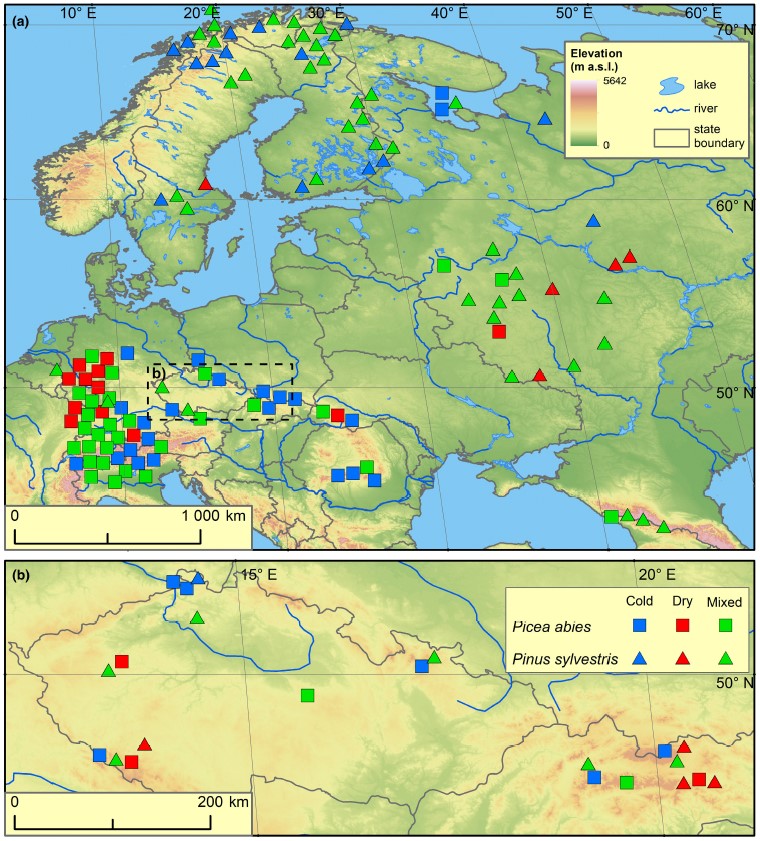 Radial tree growth is sensitive to environmental conditions, making observed growth increments an important indicator of climate change effects on forest growth. To systematically assess potential drivers of non-stationarity, we compiled tree-ring width chronologies of two conifer species, Picea abies and Pinus sylvestris, distributed across cold, dry, and mixed climates. We analyzed 147 sites across the Europe. We calibrated four numerical models to simulate growth chronologies based on temperature and soil moisture data. The degree of non-stationarity varied between species, site climatic conditions, and models. We conclude that non-stationarity in climate–growth responses is a multifactorial phenomenon driven by the interaction of site climatic conditions, tree species, and methodological features of the modeling approach. We recommend that temporal non-stationarity rather than stationarity should be considered as the baseline model of climate–growth response for temperate forests.
Radial tree growth is sensitive to environmental conditions, making observed growth increments an important indicator of climate change effects on forest growth. To systematically assess potential drivers of non-stationarity, we compiled tree-ring width chronologies of two conifer species, Picea abies and Pinus sylvestris, distributed across cold, dry, and mixed climates. We analyzed 147 sites across the Europe. We calibrated four numerical models to simulate growth chronologies based on temperature and soil moisture data. The degree of non-stationarity varied between species, site climatic conditions, and models. We conclude that non-stationarity in climate–growth responses is a multifactorial phenomenon driven by the interaction of site climatic conditions, tree species, and methodological features of the modeling approach. We recommend that temporal non-stationarity rather than stationarity should be considered as the baseline model of climate–growth response for temperate forests.





















